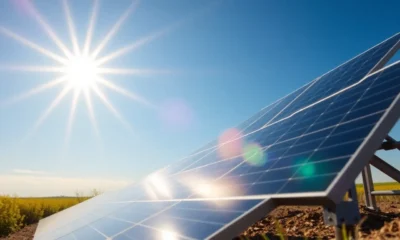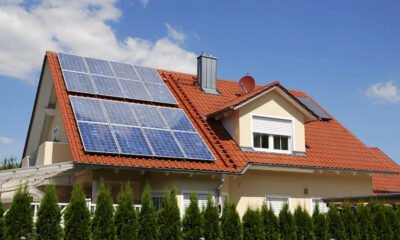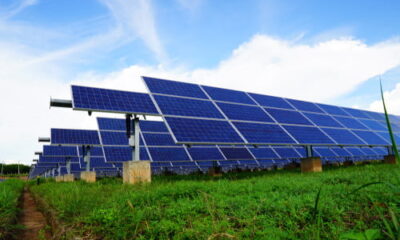

Energy
Save The Earth; Ditch Your Pilot
As concerns about the health of the planet rise, more people are looking for ways to reduce their impact on the Earth through reducing their energy consumption. This can be accomplished in a variety of ways, and the best place to start is in your home.
Home appliances require energy sources
Running the appliances in your home requires the use of energy – and the use of certain types of energy, like gas and coal, can have a big impact on the environment. This is because fuel sources like gas and coal emit carbon dioxide into the atmosphere as they are burned. And carbon dioxide is the main concern when it comes to managing man-made climate change and keeping the atmosphere clean.
Solar power has become popular over the last decade, and with good reason. The upfront costs for installation may be higher, however, using solar energy is a decent long-term strategy to save money and reduce your CO2 impact on the atmosphere.
There is one caveat many people are unaware of when it comes to solar power. Although solar panels do not emit CO2, their production process creates a good amount of CO2.
When solar isn’t an option
For those who don’t have access to solar power, there are three main sources of energy to choose from: electric, natural gas, and propane.
Electric energy is easier to maintain than gas, but can be more expensive. And like gas, electric energy generation emits CO2 into the atmosphere. It seems that no matter what source of energy you choose, you cannot escape producing CO2.
Natural gas is more affordable and because it’s delivered through an underground pipeline, it’s more dependable in adverse weather and storms. Also, natural gas has the lowest output of CO2 when burned.
Propane is not generally supplied by a power company, and requires homeowners to purchase or rent a tank that is stationed somewhere on the property. Although the homeowner is responsible for refilling the tank, the cost can be significantly less than natural gas. And propane comes in second next to natural gas for having the lowest CO2 emissions.
Although natural gas and propane are more affordable solutions to power your appliances, there is a significant drawback: the amount of energy it takes to keep a pilot light going.
Pilot lights waste energy
One of the largest sources of wasted energy in the home comes from pilot lights. A pilot light is a tiny gas burner with a flame that burns continuously in order to light other, larger burners when necessary. Pilot lights can be part of many standard gas-powered appliances such as stoves, washers, dryers, water heaters, and even refrigerators.
If your home is powered by natural gas or propane, you may have multiple pilot lights. And, if you have multiple pilot lights, you’re probably paying a good amount of money (and wasting energy) just to keep them going when not in use.
The real cost of pilot lights
If you’re able to access your gas meter, you may want to do the math to see how much your pilot lights are costing you. As many people are discovering, it can cost $170/year or more just to run two pilot lights. And if you’ve got a home full of gas-powered appliances, you may be paying a pretty penny just to keep those pilot lights going.
There is another, more permanent cost to having multiple pilot lights in your home—the environment. For every pilot light that remains lit, you’re producing CO2 as it burns, which adversely affects the environment 24 hours a day. Having a few pilot lights in your home may not seem significant, but if you think about how many other people on the planet are burning multiple pilot lights, it adds up quickly.
Pilot lights aren’t always necessary
While a home powered by natural gas is more eco-friendly than a home powered by coal and oil, it’s possible to take your energy saving efforts a step further by eliminating some of your pilot lights. Turning off your heater’s pilot light in the summer, disabling the two back burners on your stove, and installing a tankless, or on-demand water heater are three simple ways you can accomplish this. An on-demand water heater uses far less energy than a standard water heater because the pilot light and additional burners are only lit when you engage the hot water.
In addition to using less energy, an on-demand water heater is much easier to maintain since its parts are mostly replaceable. In contrast, when a traditional water heater malfunctions, the entire unit usually needs to be replaced.
Living off the grid can save the planet (eventually)
If you live off the grid, you probably use propane to power some of your appliances. By being self-sufficient, you’re telling the power companies that there is a demand for more responsible energy sources, and if enough people stop using their sources of energy, they will be more likely to offer more renewable energy sources in the future.
Saving energy saves the planet
The bigger picture is that saving the planet starts with saving energy at home. Our individual choices may not seem like they make an impact, but collectively they do.


 Environment10 months ago
Environment10 months agoAre Polymer Banknotes: an Eco-Friendly Trend or a Groundswell?

 Environment11 months ago
Environment11 months agoEco-Friendly Home Improvements: Top 7 Upgrades for 2025

 Features9 months ago
Features9 months agoEco-Friendly Cryptocurrencies: Sustainable Investment Choices

 Features10 months ago
Features10 months agoEco-Friendly Crypto Traders Must Find the Right Exchange






























